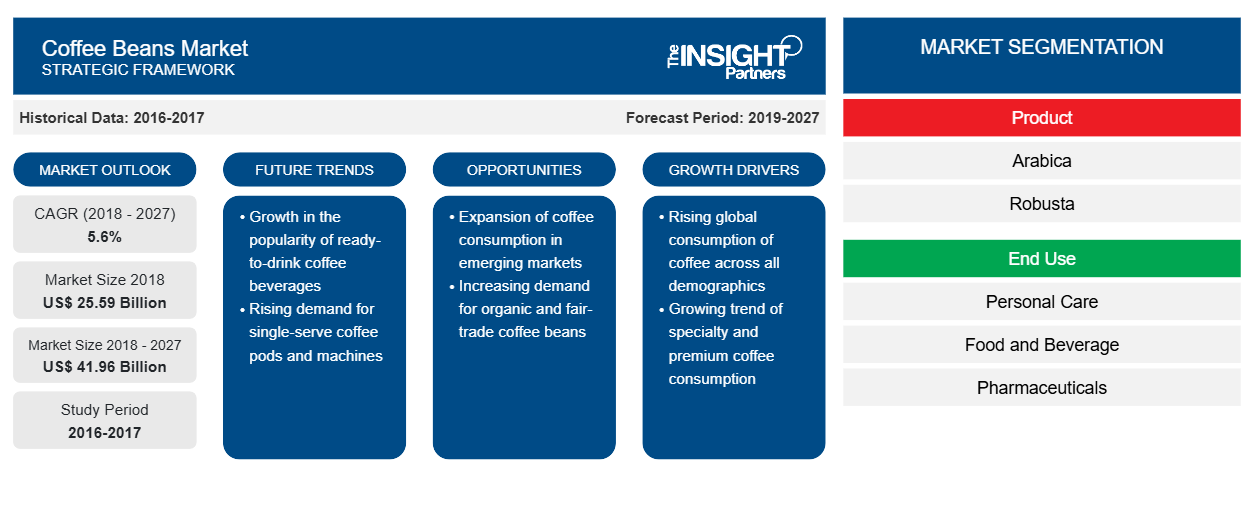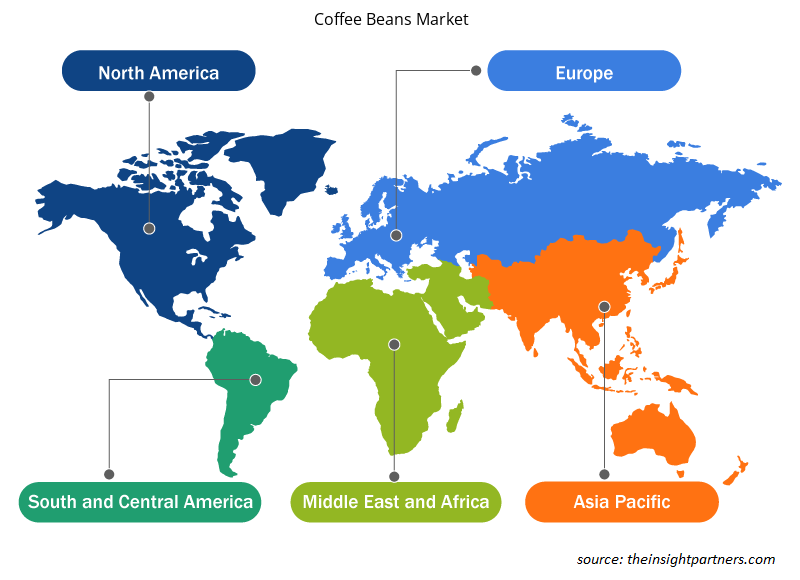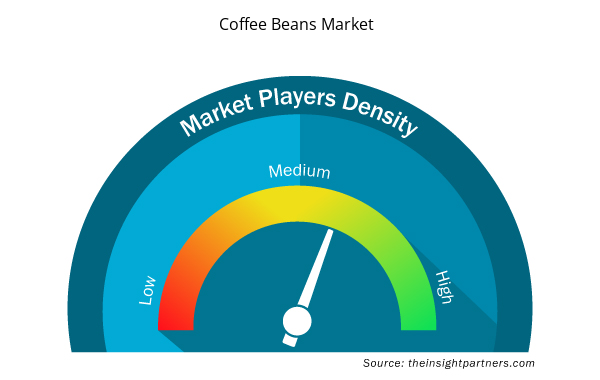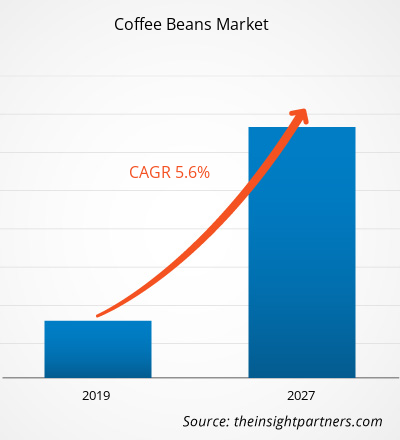[Research Report] The coffee Beans market was valued at US$ 25,591.7 million in 2018 and is projected to reach US$ 41,962.4 million by 2027; it is expected to grow at a CAGR of 5.6% from 2019 to 2027.
Coffee beans are the seeds produced by coffee plants, which are a rich source of coffee. The coffee beans are not exactly beans, but they are called coffee beans as they resemble true beans in their appearance. Just like ordinary cherries, the coffee beans are also a so-called stone fruit. The two most important varieties of coffee plants are arabica and robusta. According to some of the studies, the coffee plant was first discovered in Ethiopia by a goat herder named Kaldi. Coffee beans are a major cash crop and a crucial product for export. Based on product, the coffee beans market is segmented into arabica, robusta, and others. In 2018, the arabica segment dominated the market by accounting major market share. The Arabica trees produce fine, and aromatic coffee. The beans of Arabica are flat and elongated compared to Robusta and have lower caffeine content. The arabica coffee beans are low in calories and contain ample amount of minerals like niacin, potassium, and manganese. The high-quality arabica coffee is slightly sweet with hints of chocolates, nuts, and caramel. They might even possess little bitterness and slight acidic.
Asia Pacific region is expected to grow with a highest CAGR of 6.0% during the forecast period. The Asia Pacific region is expected to gain a significant share in the global coffee beans market owing to the increasing popularity of different coffee products among the consumers in the region. The number of coffee cafes and coffee outlets are increasing in countries such as India, Thailand, the Philippines, and Indonesia, which is further contributing to the coffee beans market. The climate, along with the geographical location of Southeast Asia, is quite ideal for coffee cultivation. Furthermore, the region’s coffee culture and expertise in coffee production have contributed to the emergence of the thriving coffee industry in this region. Some of the Southeast Asian countries have become coffee exporting giants, including Indonesia, Vietnam, and Laos. Thailand is also attracting business and investments owing to its increasing coffee demand. Additionally, the Philippines is determined to revive its coffee industry in order to target niche markets and the growing domestic demand for specialty coffee. In the current scenario, Vietnam is the second-largest coffee exporter across the world after Brazil. In the year of 2017, total coffee production accounted for 29,500,000 bags of 60kg weight, followed by Indonesia with a total production of 10,902,000 Bags.
Effect of COVID-19 upon Coffee Beans Market
COVID-19 outbreak first began in Wuhan (China) during December 2019 and since then it has spread at a fast pace across the globe. As of March 2020, China, Italy, Iran, India, Russia, Spain, republic of Korea, France, Germany, and the US are some of the worst affected countries in terms confirmed cases and reported deaths. According to the latest WHO figures, there are ~9,843, 073 confirmed cases and 495,760 deaths globally. The COVID-19 outbreak has been affecting economies and industries in various countries due to lockdowns, travel bans, and business shutdowns. The global food processing industry is one of the major industries facing serious disruptions such as factories shut down, supply chain breaks, technology events cancellations, and office shutdowns as a result of this outbreak.
Customize This Report To Suit Your Requirement
You will get customization on any report - free of charge - including parts of this report, or country-level analysis, Excel Data pack, as well as avail great offers and discounts for start-ups & universities
Coffee Beans Market: Strategic Insights

- Get Top Key Market Trends of this report.This FREE sample will include data analysis, ranging from market trends to estimates and forecasts.
Customize This Report To Suit Your Requirement
You will get customization on any report - free of charge - including parts of this report, or country-level analysis, Excel Data pack, as well as avail great offers and discounts for start-ups & universities
Coffee Beans Market: Strategic Insights

- Get Top Key Market Trends of this report.This FREE sample will include data analysis, ranging from market trends to estimates and forecasts.
Market Insights
Increase in the Consumption of Coffee and Coffee Beverages
Coffee is one of the most consumed beverages across the world. There is an upsurge in the popularity of coffee among the young population, especially in countries such as India, China, and Philippines, which fuels the demand for coffee beans. There are several leading motives for coffee consumption, such as functional, taste & pleasure, habit, tradition, culture, and socialization. The rise in the middle-class population and overall better standards of living, contribute to the increase in demand for coffee and coffee beverages. The consumption of coffee has also grown significantly among office professionals. The opening and expansion of local coffee stores and new coffee stores is another factor propelling the demand for coffee, which in turn contributes to the growth of the coffee beans market. Additionally, an increase in consumption of milk, favors the market growth as consumers mix coffee in milk for better taste. The opportunity to linger and stay for a quality long time in coffee shops also attracts the attention of the consumers, which in turn increases the demand for coffee. Besides this, coffee shops act as an alternative to the library. Besides, drinking coffee is regarded as a kind of fashion and relaxed lifestyle for young people, which in turn leads to the upsurge in demand for coffee. Coffee beans are treated in different ways for the purpose of selling in various types’ coffee blends and are present in retail shops, grocery stores and online.
Product Insights
Based on product, the coffee beans market has been segmented into arabica, robusta, and others. The Arabica segment accounted for the largest share of the global coffee beans market in 2018, and robusta segment is expected to grow at a higher CAGR during the forecast period. Arabica coffee is the oldest and most dominant species of coffee. It is obtained from the coffee shrub of Arabica and is also known as mountain coffee or coffee Arabica. Arabica coffee accounts for almost 60% of the world’s coffee production and consumption. The Arabica beans are native to Ethiopia, South Sudan, and Yemen, where they have been grown and cultivated since the 12thcentury. At present, they are grown and cultivated across the globe ranging from Africa to Latin America and Asia to the Caribbean. Arabica plants are trees or large bushes bearing white flowers and bright red berries. Each of these berries contains two seeds that eventually turn to coffee beans. Arabica plants take about seven years to completely mature and produce fruit. Besides, for those seven years, no coffee can be harvested. Arabica consists of 60% more lipids and twice the concentration of sugar compared to robusta. Arabica plants can tolerate low temperatures and grows best with average temperatures between 15 and 24 degrees. One strain of coffee Arabica contains a limited amount of caffeine. Arabica coffee is rich in antioxidants, with small amounts of vitamins & minerals like niacin, magnesium, manganese, and potassium. A good quality Arabica coffee has a slightly sweet flavor with some hints of nuts, caramel, and chocolate. Louis Dreyfus Company, Bharat Company Depot, and among others are some of the companies offering Arabica coffee beans.
End Use Insights
Based on end use, the coffee beans market has been segmented into food & beverages, personal care, and pharmaceutical. The food & beverages segment accounted for the largest share in the global coffee Beans Market in 2018, and is expected to register the fastest growth rate during the forecast period. Coffee is one of the commercialized food products and is the most widely consumed beverage worldwide. The reasons behind increase in coffee consumption include improvement in coffee quality through the selection of different varieties, improvement in agricultural practices and creation of specialty shops. Coffee beans are used in different varieties of food as they are rich in antioxidants and reduce the risk of diabetes and combat inflammation. Food items such as café mocha cookies, coffee sugar cookies, coffee rubbed steak, coffee chocolate brownie, and coffee rub crusted pork roast are made using coffee or coffee beans. The use of coffee beans in café mocha cookies not only gives a savory coffee flavor, but addsa rich chocolaty flavor as well. The coffee sugar cookies provides sweet flavor together with bits of strong and robust coffee. The decadent dessert of brownie coupled with smooth coffee flavor offer a mouthwatering taste to coffee. Coffee beverages are prepared and presented in various vogues and styles across the world, but they differ in their preparation method and ingredients used. Expresso, expresso macchiato, and cappuccino are some coffee beverages that are consumed by a majority of people.
Mergers and acquisition and research and development are commonly adopted by companies to expand their footprint worldwide, which is further impacting the size of the market. The players present in the coffee beans market such as Illycafe S.p.A and Peets Coffeehave been implementing the mergers and acquisition and research and development strategies to enlarge the customer base and to gain significant market share across the world, which also permits the players to maintain their brand name globally.For instance, in August 2019, Illycafe S.p.A announced acquisition of its UK distribution business from Euro Food Brands (EFB Group). Euro Food Brands were solely related to the distribution of Illy products in the UK. The operation is done with the intention to hire more employees needed to manage and develop the company.
Coffee Beans Market Regional Insights
The regional trends and factors influencing the Coffee Beans Market throughout the forecast period have been thoroughly explained by the analysts at Insight Partners. This section also discusses Coffee Beans Market segments and geography across North America, Europe, Asia Pacific, Middle East and Africa, and South and Central America.

- Get the Regional Specific Data for Coffee Beans Market
Coffee Beans Market Report Scope
| Report Attribute | Details |
|---|---|
| Market size in 2018 | US$ 25.59 Billion |
| Market Size by 2027 | US$ 41.96 Billion |
| Global CAGR (2018 - 2027) | 5.6% |
| Historical Data | 2016-2017 |
| Forecast period | 2019-2027 |
| Segments Covered |
By Product
|
| Regions and Countries Covered | North America
|
| Market leaders and key company profiles |
Coffee Beans Market Players Density: Understanding Its Impact on Business Dynamics
The Coffee Beans Market market is growing rapidly, driven by increasing end-user demand due to factors such as evolving consumer preferences, technological advancements, and greater awareness of the product's benefits. As demand rises, businesses are expanding their offerings, innovating to meet consumer needs, and capitalizing on emerging trends, which further fuels market growth.
Market players density refers to the distribution of firms or companies operating within a particular market or industry. It indicates how many competitors (market players) are present in a given market space relative to its size or total market value.
Major Companies operating in the Coffee Beans Market are:
- Bharat Coffee Depot
- Death Wish Coffee Company
- Gold Coffee Company
- Hawaiian Isles Kona Coffee Company, Ltd
- Kicking Horse Whole Beans
Disclaimer: The companies listed above are not ranked in any particular order.

- Get the Coffee Beans Market top key players overview
Global Coffee Beans Market – By Product
- Arabica
- Robusta
- Others
Global Coffee Beans Market – By End Use
- Food and Beverage
- Personal Care
- Pharmaceuticals
Company Profiles
- Bharat Coffee Depot
- Death Wish Coffee Company
- The Gold Coffee Company
- Hawaiian Isles Kona Coffee Company Ltd.
- Kicking Horse Whole Beans Company
- Illycafe S.p.A Company
- The Coffee Beans Co.
- Peets Coffee and Tea, Inc.
- Starbucks Coffee Company
- Direct Coffee GmbH
- Historical Analysis (2 Years), Base Year, Forecast (7 Years) with CAGR
- PEST and SWOT Analysis
- Market Size Value / Volume - Global, Regional, Country
- Industry and Competitive Landscape
- Excel Dataset


- Print Management Software Market
- Unit Heater Market
- Procedure Trays Market
- Non-Emergency Medical Transportation Market
- Medical and Research Grade Collagen Market
- Redistribution Layer Material Market
- Cell Line Development Market
- Architecture Software Market
- Small Molecule Drug Discovery Market
- Molecular Diagnostics Market

Report Coverage
Revenue forecast, Company Analysis, Industry landscape, Growth factors, and Trends

Segment Covered
Product , End Use , and Geography

Regional Scope
North America, Europe, Asia Pacific, Middle East & Africa, South & Central America

Country Scope
Argentina, Brazil, Canada, China, France, Germany, India, Italy, Japan, Mexico, Saudi Arabia, South Africa, South Korea, United Arab Emirates, United Kingdom, United States
Trends and growth analysis reports related to Food and Beverages : READ MORE..
The List of Companies - Coffee Beans Market
- Bharat Coffee Depot
- Death Wish Coffee Company
- Gold Coffee Company
- Hawaiian Isles Kona Coffee Company, Ltd
- Kicking Horse Whole Beans
- IllycaffS.p.A Company
- The Coffee Beans Co
- Peets Coffee
- Starbucks Coffee Company
- Direct Coffee GmbH

 Get Free Sample For
Get Free Sample For